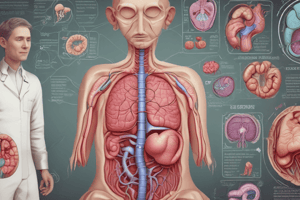Podcast
Questions and Answers
What is the typical age range of infants affected by infantile pyloric stenosis?
What is the typical age range of infants affected by infantile pyloric stenosis?
- 4-6 months old
- 2-4 months old
- 6-12 months old
- 2-4 weeks old (correct)
What is the main cause of infantile pyloric stenosis?
What is the main cause of infantile pyloric stenosis?
- Hypertrophy of the pyloric muscle (correct)
- Poor feeding habits
- Infection of the pyloric muscle
- Narrowing of the pyloric canal
What is the common symptom of infantile pyloric stenosis?
What is the common symptom of infantile pyloric stenosis?
- Constipation
- Bilious vomiting
- Diarrhea
- Projectile, non-bilious vomiting (correct)
What diagnostic method can detect an enlarged pyloric muscle and pyloric canal narrowing?
What diagnostic method can detect an enlarged pyloric muscle and pyloric canal narrowing?
What is the standard of care treatment for infantile pyloric stenosis?
What is the standard of care treatment for infantile pyloric stenosis?
What is the main goal of laparoscopic pyloromyotomy?
What is the main goal of laparoscopic pyloromyotomy?
What is monitored in infants after laparoscopic pyloromyotomy?
What is monitored in infants after laparoscopic pyloromyotomy?
What is used for pain management in infants after laparoscopic pyloromyotomy?
What is used for pain management in infants after laparoscopic pyloromyotomy?
What is a common symptom of pyloric stenosis in infants?
What is a common symptom of pyloric stenosis in infants?
What can be palpated in the upper abdomen of an infant with pyloric stenosis?
What can be palpated in the upper abdomen of an infant with pyloric stenosis?
What is the primary goal of laboratory tests in diagnosing pyloric stenosis?
What is the primary goal of laboratory tests in diagnosing pyloric stenosis?
What is the typical age range of infants affected by infantile pyloric stenosis?
What is the typical age range of infants affected by infantile pyloric stenosis?
What is the characteristic finding on an ultrasound in infantile pyloric stenosis?
What is the characteristic finding on an ultrasound in infantile pyloric stenosis?
What is the male-to-female ratio of infantile pyloric stenosis?
What is the male-to-female ratio of infantile pyloric stenosis?
What is the prognosis for infants with pyloric stenosis who receive prompt treatment?
What is the prognosis for infants with pyloric stenosis who receive prompt treatment?
Flashcards are hidden until you start studying
Study Notes
Pyloric Stenosis
Infantile Pyloric Stenosis
- A congenital condition that affects infants, typically between 2-4 weeks old
- Caused by hypertrophy of the pyloric muscle, leading to narrowing of the pyloric canal
- Boys are more commonly affected than girls (4:1 ratio)
Symptoms and Diagnosis
- Common symptoms:
- Vomiting (projectile, non-bilious)
- Poor feeding
- Weight loss or failure to gain weight
- Visible peristalsis
- Diagnostic methods:
- Physical examination (palpable olive-shaped mass in the upper abdomen)
- Ultrasound (enlarged pyloric muscle and pyloric canal narrowing)
- Upper GI series (delayed gastric emptying and pyloric stenosis)
Treatment Options
- Surgical treatment is the standard of care
- Laparoscopic pyloromyotomy (see below)
- Open pyloromyotomy (alternative to laparoscopic approach)
Laparoscopic Pyloromyotomy
- Minimally invasive surgical technique
- Involves making small incisions and using a laparoscope to visualize the pylorus
- The pyloric muscle is split, releasing the narrowing and allowing for normal gastric emptying
Postoperative Care
- Infants are typically fed within a few hours after surgery
- Monitor for vomiting, fever, and wound infection
- Pain management with acetaminophen or ibuprofen
- Follow-up with pediatrician and surgeon to ensure proper healing and weight gain
Studying That Suits You
Use AI to generate personalized quizzes and flashcards to suit your learning preferences.




